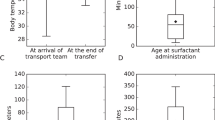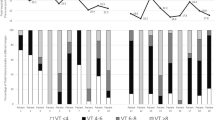Abstract
Objective
To quantify initial tidal volume (VT) during neonatal volume-targeted ventilation (VTV) and to characterize the agreement of initial VT with the limited-evidence available.
Study design
We performed a multi-center retrospective observational cohort study in two Neonatal Intensive Care Units evaluating 313 infants who received VTV as the initial ventilation modality prior to postnatal day 14. We generated descriptive statistics and performed multivariable logistic regression analysis to determine factors associated with initial VT use that agreed with available literature.
Results
154 (49%) infants received an initial VT of 5.0 mL/kg (median 5.0 mL/kg, IQR 5.0–5.1). 45 (14%) infants received an initial VT that was congruent with available literature. A birth weight of 700 –<1250 g was significantly associated with an initial VT in agreement with VT literature (aOR 9.4, 95% CI 1.7–50.4).
Conclusions
Most infants receive an initial VT of 5.0 mL/kg.
This is a preview of subscription content, access via your institution
Access options
Subscribe to this journal
Receive 12 print issues and online access
$259.00 per year
only $21.58 per issue
Buy this article
- Purchase on SpringerLink
- Instant access to full article PDF
Prices may be subject to local taxes which are calculated during checkout


Similar content being viewed by others
Data availability
A deidentified dataset and the Stata and R code used to clean the dataset may be shared with interested researchers upon request.
References
Vendettuoli V, Bellu R, Zanini R, Mosca F, Gagliardi L.Italian Neonatal Network Changes in ventilator strategies and outcomes in preterm infants. Arch Dis Child Fetal Neonatal Ed. 2014;99:F321–324.
Laptook AR, O’Shea TM, Shankaran S, Bhaskar B, Network NN. Adverse neurodevelopmental outcomes among extremely low birth weight infants with a normal head ultrasound: prevalence and antecedents. Pediatrics. 2005;115:673–80.
Guillot M, Guo T, Ufkes S, Schneider J, Synnes A, Chau V, et al. Mechanical ventilation duration, brainstem development, and neurodevelopment in children born preterm: a prospective cohort study. J Pediatr. 2020;226:87–95.e83.
Jensen EA, DeMauro SB, Kornhauser M, Aghai ZH, Greenspan JS, Dysart KC. Effects of multiple ventilation courses and duration of mechanical ventilation on respiratory outcomes in extremely low-birth-weight infants. JAMA Pediatr. 2015;169:1011–7.
Islam JY, Keller RL, Aschner JL, Hartert TV, Moore PE. Understanding the short- and long-term respiratory outcomes of prematurity and Bronchopulmonary Dysplasia. Am J Respir Crit Care Med. 2015;192:134–56.
Klingenberg C, Wheeler KI, McCallion N, Morley CJ, Davis PG. Volume-targeted versus pressure-limited ventilation in neonates. Cochrane Database Syst Rev. 2017;10:CD003666.
Gupta A, Keszler M. Survey of ventilation practices in the neonatal intensive care units of the United States and Canada: use of volume-targeted ventilation and barriers to its use. Am J Perinatol. 2018;36:484–9.
Dawson C, Davies MW. Volume-targeted ventilation and arterial carbon dioxide in neonates. J Paediatr Child Health. 2005;41:518–21.
Nassabeh-Montazami S, Abubakar KM, Keszler M. The impact of instrumental dead-space in volume-targeted ventilation of the extremely low birth weight (ELBW) infant. Pediatr Pulmonol. 2009;44:128–33.
Keszler M, Nassabeh-Montazami S, Abubakar K. Evolution of tidal volume requirement during the first 3 weeks of life in infants <800 g ventilated with Volume Guarantee. Arch Dis Child Fetal Neonatal Ed. 2009;94:F279–282.
Sharma S, Abubakar KM, Keszler M. Tidal volume in infants with congenital diaphragmatic hernia supported with conventional mechanical ventilation. Am J Perinatol. 2015;32:577–82.
Sharma S, Clark S, Abubakar K, Keszler M. Tidal volume requirement in mechanically ventilated infants with meconium aspiration syndrome. Am J Perinatol. 2015;32:916–9.
Keszler M. Volume-targeted ventilation: one size does not fit all. Evidence-based recommendations for successful use. Arch Dis Child Fetal Neonatal Ed. 2019;104:F108–F112.
Dassios T, Dixon P, Hickey A, Fouzas S, Greenough A. Physiological and anatomical dead space in mechanically ventilated newborn infants. Pediatr Pulmonol. 2018;53:57–63.
Hatch LD, Sala C, Araya W, Rivard M, Bolton J, Rivard A, et al. Increasing volume-targeted ventilation use in the NICU. Pediatrics. 2021;147:e20201500.
Tarnow-Mordi W, Parry G. The CRIB score. Lancet. 1993;342:1365.
te Pas AB, Kamlin CO, Dawson JA, O’Donnell C, Sokol J, Stewart M, et al. Ventilation and spontaneous breathing at birth of infants with congenital diaphragmatic hernia. J Pediatr. 2009;154:369–73.
Henderson-Smart DJ, De Paoli AG, Clark RH, Bhuta T. High frequency oscillatory ventilation versus conventional ventilation for infants with severe pulmonary dysfunction born at or near term. Cochrane Database Syst Rev. 2009;2009:CD002974.
Hunt K, Dassios T, Ali K, Greenough A. Volume targeting levels and work of breathing in infants with evolving or established bronchopulmonary dysplasia. Arch Dis Child Fetal Neonatal Ed. 2019;104:F46–f49.
Abman SH, Collaco JM, Shepherd EG, Keszler M, Cuevas-Guaman M, Welty SE, et al. Interdisciplinary care of children with severe Bronchopulmonary Dysplasia. J Pediatr. 2017;181:12–28.e11.
Brower RG, Matthay MA, Morris A, Schoenfeld D, Thompson BT, Wheeler A. Ventilation with lower tidal volumes as compared with traditional tidal volumes for acute lung injury and the acute respiratory distress syndrome. N. Engl J Med. 2000;342:1301–8.
Clark RH, Slutsky AS, Gerstmann DR. Lung protective strategies of ventilation in the neonate: what are they? Pediatrics. 2000;105:112–4. 1 Pt 1
Lista G, Castoldi F, Fontana P, Reali R, Reggiani A, Bianchi S, et al. Lung inflammation in preterm infants with respiratory distress syndrome: effects of ventilation with different tidal volumes. Pediatr Pulmonol. 2006;41:357–63.
Acknowledgements
We express our deepest gratitude to Steven Steele, Theresa Rogers, and Eva Dye, DNP who helped with research data collection for this study.
Funding
LAK received funding by the National Library of Medicine T15 LM007450 to perform this study. LDH was supported by the Vanderbilt Department of Pediatrics Turner-Hazinski Faculty Scholars Award and the Gerber Foundation. Use of the Research Electronic Data Capture program was supported by UL1 TR000445 from NCATS/NIH.
Author information
Authors and Affiliations
Contributions
LAK, MWA, CUL, and LDH conceived this project and outlined the primary objectives for this manuscript. LAK and LDH extracted and reviewed the ventilator data and performed the data analyses. SOG implemented and extracted data from the Jackson-Madison NICU location. LAK, MWA, ABM, and AW assisted with data extraction and transformation of data extracted from the electronic health record. LAK, MWA, and LDH produced the first draft of the manuscript for publication. All authors critically appraised and approved the final submitted version of the manuscript.
Corresponding author
Ethics declarations
Competing interests
The authors declare no competing interests.
Additional information
Publisher’s note Springer Nature remains neutral with regard to jurisdictional claims in published maps and institutional affiliations.
Rights and permissions
About this article
Cite this article
Knake, L.A., Alrifai, M.W., McCoy, A.B. et al. Factors associated with initial tidal volume selection during neonatal volume-targeted ventilation in two NICUs: a retrospective cohort study. J Perinatol 42, 756–760 (2022). https://doi.org/10.1038/s41372-022-01362-0
Received:
Revised:
Accepted:
Published:
Issue date:
DOI: https://doi.org/10.1038/s41372-022-01362-0



